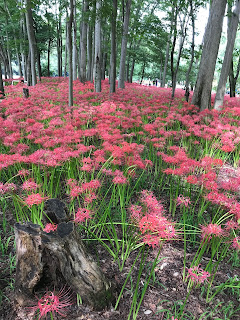This dessert is called agar. I've had it several times before, and I love it. It can be dressed up or left alone. It doesn't matter to me. Sometimes canned fruit or sweetened red bean paste (a ball of it on the side) or even soft serve is added, sometimes only a simple sweet syrup is drizzled on it. A person could eat it plain, but then it isn't really dessert, is it?
Instead of purchasing agar, we decided to make it from scratch. When we went to Shikinejima, we bought some of the red algae required to make agar. The seaweed came in a big, dry clump in a plastic bag. Making it was really quite simple.
We washed it thoroughly and prepared 2 liters of boiling water on the stove.
Once it was boiling, we added 1 tsp of vinegar along with the seaweed. The vinegar helps the seaweed to break down and release the gelatin. We let it simmer for 30 minutes.
The liquid needed to be strained through paper towels to ensure none of the little seaweed bits went into the gelatin. The instructions said to squeeze the seaweed, but it was too hot at first and once the liquid cooled it quickly jells. So, we just did the best we could with a spatula.
We poured the liquid into a square pan and let it sit until it was firm. One nice thing about agar is that it doesn't require refrigeration. It jells at room temperature. Of course, if you want it to jell quicker a cool fridge always helps.
We made the agar around 4:30 and ate it after dinner at 7:00 with the help of the fridge. I'm sure it would have been fine regardless. But when you have an impending bedtime for a 5 year old, you don't mess around with "maybe it will be fine."
To serve it, we chose eat it with just a drizzle of kuromitsu on top. Kuromitsu is a sugar syrup that is very popular in Japan. The name literally means "black honey." It is similar to molasses or maple syrup, but thinner and milder. It adds a gentle sweetness to the otherwise very plain agar.
Making agar from scratch was fun. It was almost like a science experiment for our son (which if you really think about it, all cooking is science). Taking something from the sea and transforming it into something so vastly different was entertaining for all of us.
At one point my husband chuckled to himself that sometimes our family is more Japanese than most Japanese families. Agar can be purchased in powder form and quickly blended together in less than a minute before cooling. I would guess that even though most families have made agar in their home, the majority of them have never made it from the seaweed.
No matter how it is made, it is a lovely light dessert that is very popular in Japan.



























































